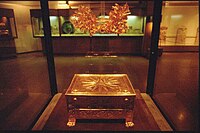Larnax

A larnax (plural larnakes) is a type of small closed coffin, box or "ash-chest" often used as a container for human remains in ancient Greece, either a body (bent on itself) or cremated ashes.
The first larnakes appeared in Minoan times during the Greek Bronze Age, when they took the form of a ceramic coffer designed to imitate a wooden chest, perhaps on the pattern of Egyptian linen chests. They were richly decorated with abstract patterns, octopuses and scenes of hunting and cult rituals.[1]
During the later Hellenistic period, larnakes in the form of a small terracotta sarcophagus became popular, some of which were painted in similar styles to contemporary Greek vases.
In a few special cases, larnakes appear to have been made out of precious materials, as in the 4th century BC example found at Vergina in northern Greece, of gold, with a sun motif (the source of the Vergina Sun motif) on the lid. The tomb where it was found is thought to have belonged to King Philip II of Macedon, father of Alexander the Great. When found, it contained the ashes of an unknown cremated male, claimed to be Phillip himself.
